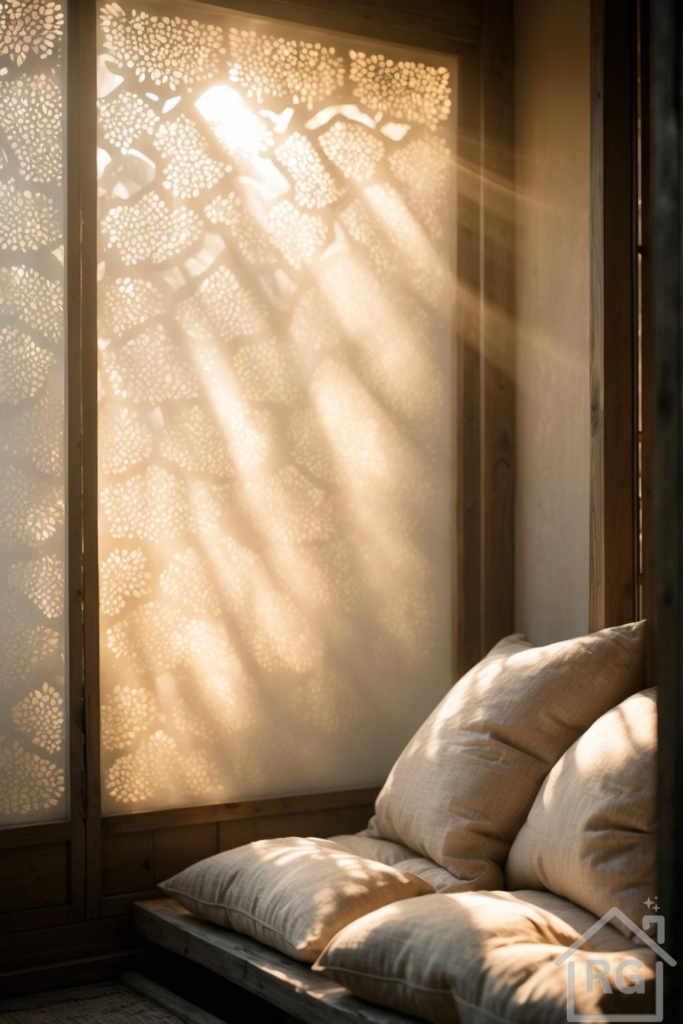
In a world that often feels chaotic and overstimulated, the desire for a personal sanctuary has never been stronger. Enter the Japandi sitting nook – a harmonious blend of Japanese minimalism and Scandinavian warmth, designed to offer a pocket of peace and introspection within your home. The image before us perfectly encapsulates this aesthetic: a sun-drenched corner, inviting and serene, promising quiet moments of contemplation or a cozy spot for reading.
The Essence of Japandi Design
Japandi is more than just a trend; it’s a philosophy that marries the rustic simplicity of Scandinavian design with the elegant minimalism of Japanese aesthetics. It’s about finding beauty in imperfection (Wabi-Sabi), embracing natural materials, and prioritizing functionality and comfort. The result is a space that feels uncluttered, calming, and deeply connected to nature.
Key Elements from Our Inspiration Nook
Let’s break down the elements that make this particular sitting nook so captivating and how you can replicate its serene charm:
- Natural Light: The most striking feature is the golden sunlight pouring through the window, creating a warm, ethereal glow. This isn’t just illumination; it’s an integral part of the room’s mood, highlighting textures and casting beautiful, dancing shadows.
- Patterned Screen: The intricate, organic pattern on the screen acts as a soft filter for the light, adding visual interest without overwhelming the minimalist aesthetic. It evokes traditional Japanese shoji screens but with a contemporary, artistic twist.
- Warm Neutral Palette: The dominant colors are soft beiges, creamy whites, and rich, earthy browns from the wood. This palette is inherently calming and allows the play of light and shadow to become the true “color” of the space.
- Natural Materials: The robust wooden base, likely a low daybed or platform, grounds the space with its honest, unvarnished texture. The cushions, appearing to be made of linen or a similar natural fiber, add softness and comfort.
- Low-Profile Furniture: True to Japandi principles, the seating is low to the ground, fostering a sense of groundedness and connection to the earth. This encourages a relaxed posture and a slower pace of life.
Crafting Your Own Japandi Sanctuary: A Step-by-Step Guide
1. Embrace the Power of Light
Natural light is paramount in Japandi design. Identify a corner in your home that receives ample sunlight, especially during the times you envision using your nook. If direct sunlight is too harsh, consider sheer blinds or a decorative screen like the one in our inspiration image. This allows light to filter gently, creating a soft, diffused ambiance. For evenings, incorporate subtle, warm artificial lighting – perhaps a low-slung paper lantern or a minimalist floor lamp that casts a soft glow rather than harsh illumination.
2. Curate a Calming Color Palette
Think warm, earthy neutrals. Start with a base of soft creams, gentle off-whites, and muted beiges for walls and larger textiles. Introduce depth with natural wood tones, from light oak to deeper walnut. Accents can come from subtle greens of plants or the soft grey of a stone element. Avoid bright, jarring colors; the goal is harmony and tranquility.
3. Select Honest, Natural Materials
The beauty of Japandi lies in its reverence for natural materials. Prioritize:
- Wood: Opt for light-colored woods like birch, ash, or light oak for furniture, or embrace the deeper, richer tones of walnut or reclaimed wood for a more grounded feel. Look for pieces that showcase the natural grain.
- Textiles: Linen, cotton, wool, and hemp are your best friends. Choose fabrics with visible texture but a soft hand. Think chunky knits, slubby linens, and soft cottons for cushions, throws, and curtains.
- Paper: As seen in the inspiration image, paper screens (like shoji panels) are excellent for diffusing light and adding a touch of traditional Japanese elegance.
- Ceramics & Stone: Introduce these through minimalist pottery, a small stone coaster, or a simple vase. Their organic textures add an authentic, grounded feel.
4. Choose Low-Profile, Functional Furniture
The furniture in a Japandi nook should be simple, functional, and low to the ground. Consider:
- Floor Cushions & Mattresses: Instead of a traditional sofa, a low wooden platform topped with thick, comfortable floor cushions or a futon-style mattress creates an inviting, relaxed seating area.
- Minimalist Benches: A simple, sturdy wooden bench can serve as both seating and a surface for a book or a cup of tea.
- Small Side Tables: A low, unobtrusive side table made of wood or ceramic is perfect for holding essentials without cluttering the space.
5. Add Thoughtful Details and Textures
While minimalism is key, a Japandi space is far from stark. It’s about thoughtful layering of textures and subtle details:
- Textured Cushions: The cushions in our image, likely linen, add a tactile quality. Mix different natural fabrics for subtle variation.
- Subtle Patterns: The patterned screen is a perfect example of how to introduce pattern without overwhelming. Look for organic, abstract, or geometric patterns that are understated and harmonious with the natural palette.
- Greenery: A single, elegant houseplant – perhaps a snake plant, a fiddle-leaf fig, or a bonsai – can bring life and a touch of nature indoors. Choose plants with clean lines and simple pots.
- Art: If you choose to include art, opt for abstract pieces, nature-inspired prints, or minimalist pottery that complements the serene atmosphere.
6. Cultivate a Sense of Calm and Simplicity
Beyond the physical elements, the true essence of a Japandi nook lies in the feeling it evokes. Keep the space free from clutter. Each item should have a purpose or bring you joy. Practice mindfulness when you’re in the space – whether it’s sipping tea, reading, or simply observing the light. This intentionality transforms a mere corner into a true sanctuary.
Maintaining Your Japandi Nook
Simplicity extends to maintenance. Natural materials are often durable and age beautifully, acquiring a patina over time. Regular dusting, occasional cleaning of textiles, and allowing natural light to air out the space will keep it feeling fresh and inviting. Embrace the slight imperfections that come with natural materials; they tell a story and add character.
Conclusion
Creating a Japandi sitting nook is an investment in your well-being. It’s about designing a space that encourages you to slow down, breathe, and find peace amidst the everyday hustle. By carefully selecting natural materials, embracing a calming color palette, and prioritizing functionality and simplicity, you can transform any corner into a serene haven. Begin your journey to a more tranquil home today – your personal sanctuary awaits.
